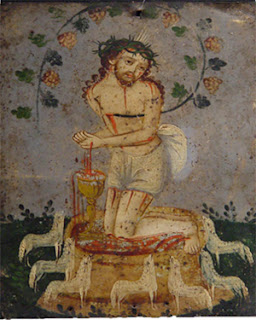The Pensive Christ which we saw in our last Blog has a similar depiction in MAN OF SORROWS(the Latin term Christus dolens ("suffering Christ"), a biblical term, is paramount among the prefigurations of the Messiah identified by the Bible in the passages of Isaiah 53* (Servant songs) in the Hebrew Bible. It is also an iconic devotional image that shows Christ, usually naked above the waist, with the wounds of his Passion prominently displayed on his hands and side, often crowned with the crown of thorns and sometimes attended by angels. It developed in Europe from the 13th century and was especially popular in
The image continued to spread and develop iconographical complexity until well after the Renaissance, but the Man of Sorrows in its many artistic forms is the most precise visual expression of the piety of the later Middle Ages, which took its character from mystical contemplation rather than from theological speculation.
Other elements that were sometimes included, in distinct sub-forms of the image, included "Instruments of the Passion", the cross, a chalice into which blood poured from Christ's side or other wounds (giving an emphasis on the Eucharist), angels to hold these objects or support a slumped Christ himself (Meister Francke shows both roles below), and mourners or worshippers.
Together with the Pietà, it was the most popular of the Andachtsbilder-type images of the period.
While there are many examples from the Middle Ages, we have few from more modern times. The 19th C found examples in the Retable from from
* Isaiah 53 : He is despised and rejected of men, a Man of sorrows, and acquainted with grief. And we hid as it were our faces from Him; He was despised, and we esteemed Him not. Surely He hath borne our griefs and carried our sorrows; yet we did esteem Him stricken, smitten of God, and afflicted. But He was wounded for our transgressions; He was bruised for our iniquities. The chastisement of our peace was upon Him, and with His stripes we are healed.
Images:
Top left- German woodcut c. 1465
Mid right- Meister Francke c. 1430
Mid left- 19th C. Mexico - Anonymous
Bottom right- James B Janknegt - USA



